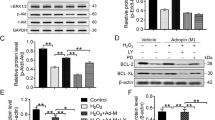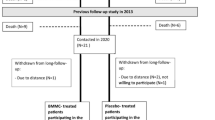Abstract
We investigated the impact of bone marrow-derived mesenchymal stem cells (BM-MSCs) alone or in combination with hepatocyte growth factor (HGF) transplantation via noninfarct-relative artery in a swine myocardial infarction (MI) model. Donor BM-MSCs were derived in vitro from swine auto-bone marrow cultures labeled by bromodeoxyuridine (BrdU) incorporation. Host MI swine model was created by ligating the distal left anterior descending artery. After 4 weeks, age-matched male MI swines were used for the transplantation. Male MI swines were transfused via noninfarct-relative artery with vehicle (control, n=6) or BrdU-labeled BM-MSCs (5 × 106) alone (MSCs, n=6) or BrdU-labeled BM-MSCs (5 × 106) combined with HGF (4 × 109 PFU) (MSCs+HGF, n=6). To evaluate the collateral artery growth (Rentrop) and cardiac perfusion in these animals, gate cardiac perfusion imaging and coronary angiography were performed before and 4 weeks after transplantation, respectively. To assess the contribution of donor-originated cells in stimulation of cardiomyocyte regeneration and angiogenesis, immunohistochemistry for BrdU and α-smooth muscle actin (α-SMA) and quantitative image analysis were performed at 4 weeks after transplantation. The results are as follows: (1) BrdU-positive cells were detected in host myocardium in both MSCs and MSCs+HGF groups, but not in the vehicle group. Most BrdU-positive cells expressed myosin heavy chain β. (2) α-SMA-positive arteriole densities in the infarcted border area and infarcted area were increased significantly in both transplantation groups compared with the vehicle group. (3) Gate cardiac perfusion imaging demonstrated that the cardiac perfusion was significantly improved in transplantation groups compared with the vehicle group. (4) Ejection fraction and α-SMA-positive arteriole densities were increased significantly in both transplantation groups compared with the vehicle group. However, there was no difference in ejection fraction and α-SMA-positive arteriole densities between the MSCs group and the MSCs+HGF group. Growth of collateral arteries was not detected by coronary angiography in all three groups. In conclusion, the current study indicates that BM-MSCs transplantation via noninfarct-relative artery stimulates cardiomyocyte regeneration and angiogenesis and improves cardiac function, but does not stimulate collateral artery growth. BM-MSCs transplantation combined with HGF therapy is not superior to BM-MSCs alone transplantation. BM-MSCs transplantation via noninfarct-relative artery may be an alternative for those patients who cannot be transplanted via infarct-relative artery in clinical practice.
This is a preview of subscription content, access via your institution
Access options
Subscribe to this journal
Receive 12 print issues and online access
$259.00 per year
only $21.58 per issue
Buy this article
- Purchase on Springer Link
- Instant access to full article PDF
Prices may be subject to local taxes which are calculated during checkout




Similar content being viewed by others
References
Tomita S, Mickle DA, Weisel RD, Jia ZQ, Tumiati LC, Allidina Y et al. Improved heart function with myogenesis and angiogenesis after autologous porcine bone marrow stromal cell transplantation. J Thoracic Cardiovasc 2002; 123: 1132–1140.
Barbash IM, Chouraqui P, Baron J, Feinberg MS, Etzion S, Tessone A et al. Systemic delivery of bone marrow-derived mesenchymal stem cells to the infarcted myocardium. Circulation 2003; 108: 863–868.
Jin H, Wyss JM, Yang R, Schwall R . The therapeutic potential of hepatocyte growth factor for myocardial infarction and heart failure current. Pharmaceutical Des 2004; 10: 2525–2533.
Matsumoto K, Nakamura T . Hepatocyte growth factor: renotropic role and potential therapeutics for renal diseases. Kidney Int 2001; 59: 2023–2038.
Rentrop KP, Cohen M, Blanke H, Phillips RA . Change in collateral channel filling immediately after controlled coronary artery occlusion by an angioplasty balloon in human subjects. J Am Coll Cardial 1985; 5: 587–592.
Kraitchman DL, Tatsumi M, Gilson WD, Ishimori T, Kedziorek D, Walczak P et al. Dynamic imaging of allogeneic mesenchymal stem cells trafficking to myocardial infarction. Circulation 2005; 112: 1451–1461.
Orlic D, Hill JM, Arai AE . Stem cells for myocardial regeneration. Circ Res 2002; 91: 1092.
White FC, Carroll SM, Magnet A, Bloor CM . Coronary collateral development in swine after coronary artery occlusion. Circ Res 1992; 71: 1490–1500.
Dimmeler S, Zeiher AM, Schneider MD . Unchain my heart: the scientific foundations of cardiac repair. J Clin Invest 2005; 115: 572–583.
Wang JS, Shum-Tim D, Galipeau J, Chedrawy E, Eliopoulos N, Chiu RC . Marrow stromal cells for cellar cardiomyoplasty: feasibility and potential clinical advantages. Thorac cardiovasc surg 2000; 120: 999–1006.
Orlic D, Kajstura J, Chimenti S, Jakoniuk I, Anderson SM, Li B et al. Bone marrow cells regenerate infracted myocardium. Nature 2001; 410: 701–705.
Wakitani S, Saito T, Caplan AI . Myogenic cells derived from rat bone marrow mesenchymal stem cells exposed to 5-azacytidine. Muscle Nerve 1995; 18: 1417–1426.
Tomita S, Li RK, Weisel RD, Mickle DA, Kim EJ, Sakai T et al. Autologous transplantation of bone marrow cells improves damaged heart function. Circulation 1999; 100: II-247–II-256.
Zhang YR, Wu DL, Lao MF, Bi JJ, Wu ZZ . The comparative efficacy of recombinant adenovirus and plasmid in treatment of myocardial ischemia. Bull Acad Military Med Sci 2003; 27: 16–18.
Wu DL, Zhang YR, Lao MF, Yuan LZ, Wang L, Ha XQ et al. Therapeutic induction of angiogenesis by direct myocardial administration of an adenovirus vector encoding human hepatocyte growth factor gene and its safety. Chinese Sci Bull 2004; 49: 1464–1469.
Acknowledgements
This work was supported by a grant from the Natural Science Foundation of Jiangsu Province (no. RC2002043).
Author information
Authors and Affiliations
Corresponding author
Rights and permissions
About this article
Cite this article
Yang, Zj., Ma, Dc., Wang, W. et al. Experimental study of bone marrow-derived mesenchymal stem cells combined with hepatocyte growth factor transplantation via noninfarct-relative artery in acute myocardial infarction. Gene Ther 13, 1564–1568 (2006). https://doi.org/10.1038/sj.gt.3302820
Received:
Revised:
Accepted:
Published:
Issue Date:
DOI: https://doi.org/10.1038/sj.gt.3302820
Keywords
This article is cited by
-
Stem cell death and survival in heart regeneration and repair
Apoptosis (2016)
-
Mesenchymal stem cells overexpressing integrin-linked kinase attenuate left ventricular remodeling and improve cardiac function after myocardial infarction
Molecular and Cellular Biochemistry (2014)
-
Hepatocyte growth factor gene-modified bone marrow-derived mesenchymal stem cells transplantation promotes angiogenesis in a rat model of hindlimb ischemia
Journal of Huazhong University of Science and Technology [Medical Sciences] (2013)
-
Effect of the calcium sensing receptor on rat bone marrow-derived mesenchymal stem cell proliferation through the ERK1/2 pathway
Molecular Biology Reports (2012)
-
Hepatocyte growth factor promotes liver regeneration induced by transfusion of bone marrow mononuclear cells in a murine acute liver failure model
Journal of Hepato-Biliary-Pancreatic Sciences (2011)



